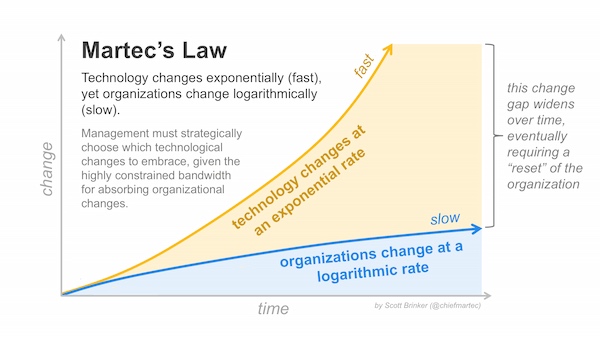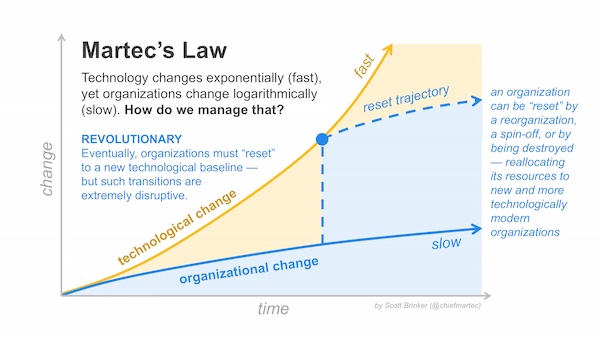Three years ago, I described a conundrum that I dubbed Martec’s Law:
Technology changes exponentially, but organizations change logarithmically.
As shown in the graph above, we know that technology changes at an exponential rate. This is the phenomenon of Moore’s Law — and, more broadly, Kurzweil’s Law of Accelerating Returns. But we also know that human organizations don’t change that quickly. Changes in behavior and culture take time. There are only so many changes in people, processes, and technology that an organization can productively absorb at once — at least without a major disruption.
So approximately speaking, organizations change at a logarithmic rate — much slower than exponential technological change.
In my opinion, Martec’s Law encapsulates the greatest management challenge of the 21st century: how do we manage relatively slow-changing organizations in a rapidly changing technological environment? It is a hard problem.
I’ll describe ways in which companies can address that challenge. But first, let me provide some context and evidence of this external/internal gap in marketing technology.
Marketing Technology and the Inverse Lake Wobegon Effect
The State of Marketing Technology 2017 report was recently published by Walker Sands (with contributions from yours truly), from a study of 335 U.S. marketers. Two of the questions they asked participants:
- How do you feel the marketing technology landscape has evolved in the past three years?
- How do you feel your company’s use of marketing technology has evolved in the past three years?
In other words: how fast is technology changing and how fast is your organization changing with it? The data reveals the widening gap of Martec’s Law:

The majority of marketers (72%) feel that the marketing technology landscape is changing either “rapidly” or at “light speed” — which is evident from the explosive growth we’ve seen in that landscape graphic over the past 5 years.
In contrast, the majority of marketers (67%) say that their company’s own use of marketing technology is evolving only “slightly” or “steadily” — or “not at all.”
This is Martec’s Law: technology is changing faster than organizations.
And while you might predict that the marketing technology landscape is bound to settle down soon, keep in mind that we’re now on the cusp on an explosion of new innovations in virtual reality, augmented reality, the Internet of Things, conversational interfaces, robotics, artificial intelligence, and so on. The next three years are likely to see more technological change than the last three. (Sorry.)
In addition to Martec’s Law, this also triggers something I characterize as the Inverse Lake Wobegon Effect in marketing.
The Lake Wobegon Effect states that we tend to overestimate our capabilities — we think we’re better at things than we actually are. It’s a humorous reference to Lake Wobegon from A Prairie Home Companion, a town where “all the children are above average.” (By the definition of average, at least one would have to be below the average of his or her peers.)
The Inverse Lake Wobegon Effect is the opposite of that: we think we’re worse at something that we actually are — we all believe that we’re below average in our peer group.
Thanks to the ever widening gap between technological change and organizational change of Martec’s Law, modern marketers always feel behind — even when they’re making remarkable progress by any absolute measure. This paradox can be visualized like this:

This is really just a slightly different way of illustrating Martec’s Law.
But just as not all of the children in Wobegon can be above average, not all marketers can be below average either. If it feels like you’re struggling to keep up, take comfort in knowing that pretty much everyone else who is paying attention feels the same.
(I do worry about the 1% of the marketers in the Walker Sands study who said the marketing technology landscape has evolved “not at all” in the past three years. Better do a pulse check.)
4 Ways to Deal with Martec’s Law
So how do we manage Martec’s Law?
First, take a deep breath and don’t succumb to the Inverse Lake Wobegon Effect. Recognize that we now live in a world of perpetual change, and so we’re never going to be fully caught up ever again. It’s the journey, not the destination.
Second, the art of managing Martec’s Law largely comes down to deciding which technology changes to embrace — and which to forgo, at least for the moment. We can only absorb a tiny fraction of changes into our existing organization at any given point in time. Therefore, we must strategically choose the few that we believe will have the greatest impact.
Let the others go. Trying to change too many things simultaneously leads to disaster. Instead, we must ruthlessly prioritize the subset of changes that best align with our company’s strategy. (Having a clear strategy by which to make these choices is essential.)
Third, strive to become a more agile organization to accelerate the rate at which you’re able to absorb changes. Practices such as lean and agile marketing, as well as other software-inspired management techniques, can increase your company’s metabolism. Forgive the quick plug, but my book Hacking Marketing explains many of these agile concepts and methodologies and describes how to adopt them within marketing.
You can also apply this same agile thinking to the architecture of a marketing technology stack. By explicitly “designing for change,” you can build a stack that facilitates new products and services being swapped in, while older ones can be gracefully sundowned and removed. Microservices — the software architectures used by digital natives such as Amazon, Google, Netflix, Spotify, and Uber — are emerging as a powerful pattern for marketing stacks to achieve such adaptability.
Still, there’s a limit to evolutionary change. Even a highly agile organization cannot change continuously at an exponential rate.
So fourth, every now and again, we should be prepared for revolutionary change through an organizational “reset.” This is an attempt to make a large jump up the curve of technological change by adopting a whole collection of changes all at once.
“If we were starting our company from scratch today, what would it look like?”
A “reset” might be acheived through an internal reorganization or by spinning off a new group that can operate with a fresh start, separate from the inertia of the existing organization. Digital transformation initiatives typically take one of those two approaches to leap frog to a new baseline on the technology curve. The Innovator’s Solution by Clay Christensen also describes a number of strategies along these lines for harnessing disruptive innovation.
As you might imagine, these resets are often extremely disruptive. They can’t be done at scale too frequently — although larger organizations may be able to systematically spin up small, intrapreneurial “start-up” teams, within an incubator-like structure, without continuously rocking the operations of the parent company.
I do believe that Martec’s Law expresses one of the toughest management challenges of our time. But as the apocryphal Chinese blessing/curse goes, “May you live in interesting times.”
Do you have other ways of dealing with Martec’s Law that you’d like to share?
P.S. For higher resolution versions of the graphs of Martec’s Law above, simply click on the images. Feel free to use, share, and distribute those graphs any way you like.








